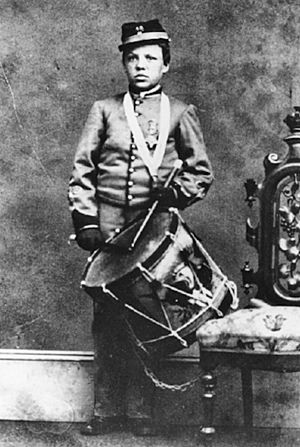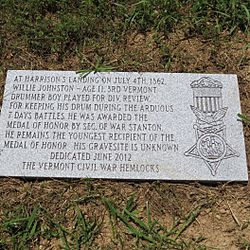Willie Johnston (Medal of Honor) facts for kids
Quick facts for kids
William J. "Willie" Johnston
|
|
|---|---|

Johnston in late 1863, shortly after receiving the Medal of Honor
|
|
| Born | July 12, 1850 Morristown, New York |
| Died | September 16, 1941 (aged 91) |
| Allegiance | United States |
| Service/ |
Union Army |
| Years of service | 1861–1865 |
| Rank | Drummer boy |
| Unit | 3rd Vermont Infantry 20th Regiment, Veteran Reserve Corps |
| Battles/wars | American Civil War |
| Awards | Medal of Honor |
| Alma mater | Norwich University (attended) |
| Other work | Machinist, Boston Navy Yard |
William J. Johnston (born July 12, 1850 – died September 16, 1941) was a brave drummer boy during the American Civil War. He served in Company D of the 3rd Vermont Infantry. During a tough retreat in 1862, he was the only drummer to keep his instrument.
His leaders were very impressed by this. Many other soldiers had dropped their heavy gear to run faster. Because he kept his drum, Willie received the Medal of Honor in 1863. He was only 13 years old, making him the youngest person ever to get this special award.
Contents
Willie Johnston's Early Life
William Johnston was born in Morristown, New York, in July 1850. His parents were Eliza and William B. H. Johnston. His mother passed away when he was young.
By 1853, his family had moved to Montreal, Canada. His father, who was a civil engineer, married Thérèse E. Martin there. Later, in 1858, the Johnston family moved to Salem, Vermont. This town is now part of Derby.
Willie Johnston's Civil War Service
Joining the Army
Willie Johnston's father joined the 3rd Vermont Infantry in June 1861. Willie formally joined Company D as a drummer on December 11, 1861. At first, he wasn't paid because officers thought he was too young.
In June 1862, he was approved to get paid. His pay was even backdated to when he first joined. Army records show he was 11 years old and five feet tall when he enlisted. His father also served in the same regiment.
The Peninsula Campaign
Willie's regiment, the 3rd Vermont, fought in the Peninsula Campaign in Virginia. This included the Seven Days Battles from June 25 to July 1, 1862. These battles were a victory for the Confederates.
On July 1, 1862, Willie's division began a nighttime retreat. Many soldiers threw away their heavy equipment to move faster. But Willie Johnston held onto his drum. His division reached Harrison's Landing early on July 2. Willie had carried his drum the whole way.
Because he was the only drummer with his instrument, Willie had the honor of drumming for the division parade on July 4. This was a very special moment for the young boy.
After the Medal
After the Peninsula campaign, Willie was reported as being wounded. He was moved to the Invalid Corps. He worked as an attendant at a hospital in Baltimore. While there, he played in the hospital's band. He was even made a drum major.
Willie re-enlisted in the 3rd Vermont on February 15, 1864. He officially left the army on August 31, 1865.
Life After the War
Willie Johnston was good at reading and writing. Letters he wrote about his army pay show he was very smart. He attended Norwich University from 1866 to 1868, but he did not graduate. In 1867, he tried to get into the United States Military Academy, but he was not chosen.
In the late 1860s, Willie played in the town band in St. Johnsbury. He later moved to Charlestown, Massachusetts. There, he married Nellie Murphy on March 1, 1870. They had five children together. Willie worked as a machinist.
In 1888, Willie's drum was found in Chelsea, Massachusetts. It had a special silver plaque on it. The drum was given to the Civil War museum at the Massachusetts State House. However, the drum has since been lost again.
Willie Johnston was alive in 1917 or later. He applied for a Civil War Campaign Medal. This medal was available to Union Army veterans.
Willie Johnston's Legacy
- In 2007, a statue of Willie Johnston was put up in Santa Clarita, California. It honors all U.S. military members.
- The Fairbanks Museum in St. Johnsbury has Civil War items. These include a photo of Willie and his drumsticks.
- In June 2012, a plaque honoring Willie was placed at Berkeley Plantation, Virginia. It tells his story and mentions he is the youngest Medal of Honor recipient.
Images for kids



